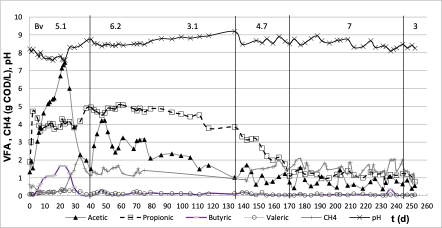 |
|
A process improvement of the anaerobic digestion of waste activated sludge (WAS) is needed to produce energy and chemicals to compensate the costs of the full wastewater treatment process. Alkaline steam explosion (A-SE) @160°C and 0.67 MPa absolute pressure, followed by thermophilic alkaline acidogenesis (50°C, pH 9) improves the WAS digestibility and the methane yields by breaking the cell walls and the extracellular polymers. This work studies the treatment time and alkalinity effects on the number of destroyed solids measured as cell damage and particle size reduction. To monitor the process a flow cytometer (FCM), through light scattering signals, proved to be an alternative to the measurement of total suspended solids by gravimetry.
The effect of alkaline acidogenesis on the volatile fatty acids (VFA) yield is studied with the A-SE suspension which is cooled down to 50°C and fed to a continuous acidogenic reactor at pH 9 under several organic loads to find the optimum (6 g CODVSS/L.d) with the highest soluble COD and VFA production rates (1.4 and 0.8 g COD/L,d respectively). This effluent can be fed to a methanogenic reactor to produce 0.5 LCH4/L.d or the VFA can be separated for the chemical industry.
Keywords: Anaerobic digestion, flow cytometry, scanning electronic microscopy, particle size reduction, cell wall.
|
|
 |

